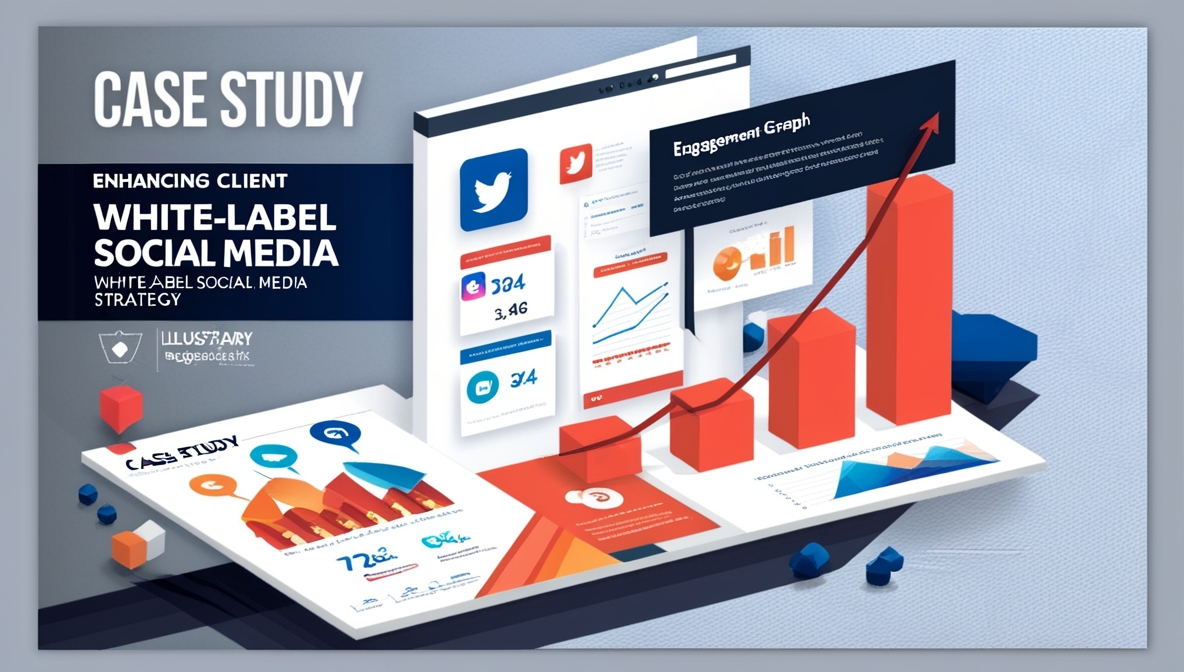Case Study: How a White-Label Social Media Strategy Enhanced Client Engagement

In today’s digitally driven marketplace, businesses continuously seek innovative strategies to deepen customer relationships and increase engagement. One proven approach gaining traction is the use of white-label social media marketing services.
This case study explores how a well-executed white-label social media strategy significantly enhanced client engagement for a mid-sized marketing agency, resulting in increased client satisfaction, higher retention rates, and measurable ROI.
Introduction to White-Label Social Media Marketing
White-label social media marketing involves outsourcing social media management and content creation to a specialized third-party provider while branding the services under the agency’s name. This model allows agencies to expand their service offerings, scale operations efficiently, and deliver expert-level social media campaigns without hiring additional in-house staff.
By leveraging white label social media marketing solutions, agencies can focus on core competencies such as client relationship management and strategic planning while ensuring that execution-level tasks are handled by experts.This case study demonstrates how integrating a white-label social media partner empowered the agency to exceed client expectations and achieve outstanding engagement results.
Client Background and Challenges
The client, a mid-sized digital marketing agency based in Sydney, Australia, specialized primarily in SEO and PPC but had limited expertise and bandwidth in social media marketing. Despite receiving increasing requests from their clients for social media services, the agency struggled to deliver consistent, high-quality campaigns due to resource constraints and a lack of specialized skills.
Their core challenges included:
- Limited Social Media Expertise: The internal team lacked dedicated social media strategists and content creators, resulting in underwhelming social media efforts.
- Scaling Constraints: Increasing social media demands from clients put pressure on existing staff, threatening to dilute service quality.
- Inconsistent Client Engagement: Social media campaigns lacked the creativity and frequency necessary to sustain client audience interest.
- Time-Consuming Execution: Developing content calendars, creating posts, and managing platforms took up significant time that distracted from core agency functions.
The agency sought a solution that would allow them to seamlessly offer social media marketing services with minimal overhead and deliver measurable results to their clients.
Strategy: Implementing a White-Label Social Media Solution
After thorough market research and vetting several providers, the agency partnered with a reputable white-label social media marketing company known for its data-driven approach and customized content strategies.
Step 1: Establishing Clear Objectives and KPIs
The agency collaborated with their white-label partner to define clear objectives for client social media campaigns. These goals focused on:
- Increasing audience engagement (likes, comments, shares)
- Growing followers organically
- Driving traffic to client websites
- Enhancing brand awareness
- Generating qualified leads through social media channels
Key performance indicators (KPIs) were established, including engagement rate, follower growth rate, click-through rates, and conversion metrics tied to social campaigns and google SEO improvements.
Step 2: Conducting Audience and Competitor Research
The white-label provider conducted in-depth research to understand each client’s target audience behavior, interests, and preferences. Simultaneously, they analyzed competitors’ social media performance to identify content gaps and opportunities.
This data informed tailored content strategies designed to resonate with target demographics and differentiate clients in crowded marketplaces.
Step 3: Crafting Customized Content Calendars
Using insights from the research phase, the provider developed detailed content calendars aligned with each client’s branding, messaging, and marketing goals. The calendars balanced promotional posts with educational, entertaining, and user-generated content to foster engagement and build community.
Post frequency and timing were optimized based on platform-specific best practices and audience activity data.
Step 4: Leveraging Visual and Interactive Content
Understanding that visuals drive higher engagement, the white-label partner produced high-quality graphics, videos, infographics, and animations that reflected the clients’ brand identity.
Interactive content such as polls, quizzes, and contests were integrated to encourage two-way communication and increase audience participation.
Step 5: Managing Social Media Platforms and Community Interaction
The white-label team handled day-to-day posting, monitoring, and responding to comments and messages promptly. They also tracked mentions and brand sentiment to address issues and capitalize on positive feedback swiftly.
By maintaining active community management, the campaigns fostered stronger relationships and trust between clients and their audiences.
Execution and Workflow Integration
The agency seamlessly integrated the white-label social media services into their existing workflow using a collaborative project management platform. This allowed for:
- Transparent progress tracking and approvals
- Regular performance reporting
- Easy communication between agency, white-label provider, and clients
Weekly and monthly meetings ensured alignment on strategy and allowed for iterative optimizations based on real-time data.
The agency retained ownership of client relationships while the white-label team focused on execution, creating a win-win partnership that maximized efficiency.
Results: Significant Improvements in Client Engagement
Over a 12-month period, the agency observed notable improvements across all key metrics for their social media clients.
Engagement Rate Increased by 65%
Posts averaged 65% more likes, comments, and shares compared to previous campaigns managed internally. The mix of compelling visual content and interactive posts drove sustained audience participation.
Follower Growth Doubled
Clients experienced a 100% increase in organic follower growth, expanding their social media reach and potential customer base. Targeted content and consistent posting schedules proved effective in attracting genuine followers.
Website Traffic from Social Channels Rose by 40%
Enhanced call-to-actions and strategic link placements in posts led to a 40% increase in traffic from social media to client websites, contributing to lead generation and conversions.
Client Retention and Satisfaction Improved
Client feedback highlighted appreciation for the professional quality and consistency of social media services. The agency reported a 30% boost in client retention rates due to the expanded service portfolio and improved results.
ROI Justified Further Investment
Increased client engagement translated into tangible business benefits, justifying the agency’s investment in the white-label partnership and encouraging plans for scaling these services further.
Lessons Learned and Best Practices
The success of this white-label social media strategy yielded several key insights:
1. Clear Communication and Goal Alignment Are Crucial
Establishing transparent communication channels and shared objectives between the agency, white-label provider, and clients ensured that everyone worked toward the same targets.
2. Data-Driven Content Creation Enhances Engagement
Thorough audience research and competitor analysis guided the creation of highly relevant, engaging content that resonated with followers.
3. Consistency Builds Trust and Momentum
Regular posting and active community management helped build ongoing relationships with audiences, increasing brand loyalty and engagement over time.
4. Visual and Interactive Content Drives Higher Interaction
Integrating diverse media formats and interactive posts significantly boosted participation compared to text-only updates.
5. Leveraging Expertise Allows Agencies to Focus on Growth
Outsourcing execution freed up the agency’s internal resources to focus on strategy, client acquisition, and relationship building.
Future Opportunities and Expansion
Encouraged by the success of this white-label social media strategy, the agency plans to:
- Expand service offerings to include paid social advertising managed by the white-label partner.
- Incorporate emerging technologies like AI-driven personalization to further boost engagement.
- Explore new platforms such as TikTok and LinkedIn to diversify client reach.
- Provide comprehensive training to in-house staff for improved collaboration with white-label teams.
Conclusion
This case study demonstrates how adopting a white-label social media marketing strategy can significantly enhance client engagement while enabling agencies to scale their services efficiently. By partnering with a specialized provider, the agency overcame internal limitations and delivered impactful, data-driven social media campaigns that boosted audience interaction, client satisfaction, and business growth.
For marketing agencies seeking to expand their offerings without the overhead of building full in-house teams, white-label social media services offer a strategic advantage. When executed with clear objectives, thorough research, and consistent communication, these partnerships can unlock substantial value and drive measurable results.





